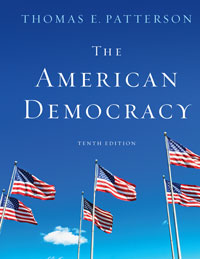 
The American Democracy, 10th Edition (Patterson)Chapter 15:
Economic and Environmental Policy: Contributing to ProsperityChapter Overview
This chapter examines economic and environmental policy. As was discussed in the first chapter, public policy is a decision by government to follow a course of action designed to produce a particular result. In this vein, economic policy aims to promote and regulate economic interests and, through fiscal and monetary actions, to foster economic growth and stability. The main ideas presented in this chapter are these:
- Through regulation, the U.S. government imposes restraints on business activity for the purpose of promoting economic efficiency and equity.
- Through regulatory and conservation policies, the U.S. government seeks to protect and preserve the environment from the actions of business firms and consumers.
- Through promotion, the U.S. government helps private interests achieve their economic goals. Business in particular benefits from the government’s promotional efforts, including, for example, tax breaks and loans.
- Through its taxing and spending decisions (fiscal policy), the U.S. government seeks to generate a level of economic supply and demand that will maintain economic prosperity.
- Through its money supply decisions (monetary policy), the U.S. government—through “the Fed”—seeks to maintain a level of inflation consistent with sustained, controllable economic growth.
 |  |
|

















